The production of pions and strange particles (K, ∧and ∑) in high energy heavy-ion collisions (HICs) was investigated systematically based on the Lanzhou Quantum Molecular Dynamics(LQMD) model that was developed by the nuclear theory group at Institute of Modern Physics(IMP), CA S. A number of available experimental data can be well described by the model, such as meson yields, π–/π+ excitation functions and transverse momentum distribution and so on. The model is a nice tool for analyzing the experimental data in Cooling and Storage Ring at Heavy Ion Research Facility in Lanzhou(HIRFL-CSR).
It has important role of the properties of the isospin asymmetric nuclear matter on the issues of astrophysics, such as the structure of neutron star, the nucleosynthesis during supernova explosion of massive stars etc. Up to now, the knowledge of the isospin asymmetric nuclear matter at high densities is very limited and the available experimental data are very scarce.
The establishment of high-energy heavy-ion facilities in the world provides a platform to explore the high-density behavior of compressed nuclear matter, such as HIRFL-CSR at IMP in China, SIS18 at GSI in Germany. Physical observables associated with the high-density information of nuclear phase diagram can be modified by the nuclear in-medium effect. A number of transport models have been used to simulate the high-density phase diagram formed in heavy-ion collisions.
Pions and strange particles in high-energy heavy-ion collisions are produced in the region of supra-saturation density. Shown in Fig. 1 is a temporal evolutions of the central density, pion, and strangeness production in the central collisions of 197Au +197Au at incident energy 1.5A GeV. The researcher investigated the influence of the Coulomb, symmetry energy, and the pion optical potential in the mean field of the LQMD model on the pion production as shown in Fig. 2. Inclusion of pion potential enhances the production of pions at high transverse momentum and improves the consistent with the available experimental data measured by FOPI collaboration. Influence of all of the three terms on total pion production is not obvious. However, both of the Coulomb and symmetry energy change the values of charged pion ratios as shown in Fig. 3. The pion potential slightly affects the ratios of charged pions.
The researcher analyzed the directed flow of pions at the cases of semi-central and peripheral collisions and compared with proton flow and the FOPI data in Fig. 4. The anti-flow of π+ is clearly in the peripheral collisions, which results from the nuclear shadowing effect of spectator nucleons through the absorption process πN→Δ. The researcher further included all channels to produce kaon in hadron-hadron collisions in the LQMD model. There are mainly two channels at near threshold energies, namely BB→BYK and πB→YK, the B stands for(N,Δ), Y(∧,∑) and K(K0,K+). The channel of πB→YK contributes roughly one third of the total kaon production. Figure 5 shows the calculated excitation functions of strange particles for the heavy 197Au + 197Au and the light 12C + 12C reactions and a comparison with the KaoS data for K+ production.
The results have been published in Physical Review C 82, 044615 (2010); 82, 057901 (2010). This work was supported by the National Natural Science Foundation of China under Grant No. 10805061, the Special Foundation of the President Fund, and the West Doctoral Project of Chinese Academy of Sciences.
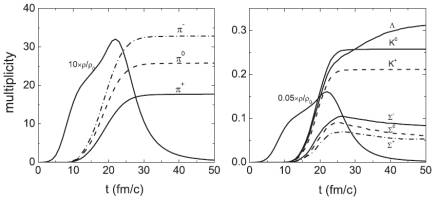
Fig. 1 A temporal evolutions of the central density, pion, and strangeness production in the central collisions of 197Au +197Au at incident energy 1.5A GeV (Image by Institute of Modern Physics)
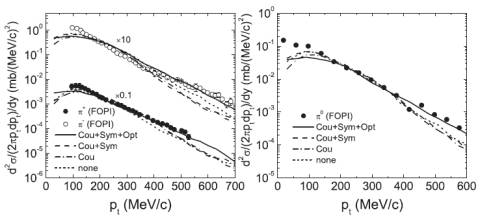
Fig. 2 Comparison of the transverse momentum distributions of π–,π+ and π0 in the reaction 197Au + 197Au at incident energy Elab = 1A GeV for the cases of including all, part, and none of the Coulomb, symmetry energy, and the pion optical potential with the available data from FOPI collaboration (Image by Institute of Modern Physics)
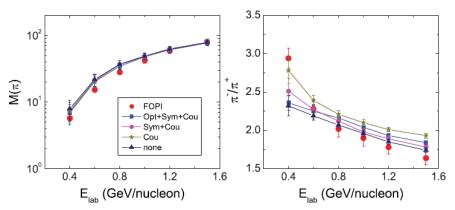
Fig. 3 The same in Fig. 2, but for the excitation functions of calculated pion multiplicity and the π–/π+ ratios. (Image by Institute of Modern Physics)
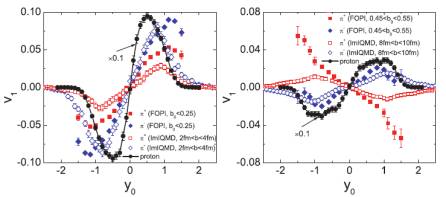
Fig. 4 Comparison of the directed flow of charged pions and protons with the FOPI data in the 197Au + 197Au reaction at incident energy Elab = 1.5A GeV for the cases of near-central and peripheral collisions. (Image by Institute of Modern Physics)
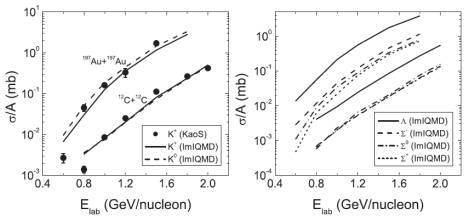
Fig. 5 Comparison of the calculated strangeness production cross section per mass number (σ/A) and the KaoS data for K+ production for the system 197Au + 197Au and the reaction 12C + 12C. (Image by Institute of Modern Physics)

